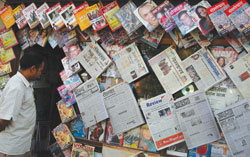|
|
After the 1990 movement, there was a surge in investment in media in Nepal. There has been similar rush for investment in Nepali media since last year's Jana Andolan. Over a dozen FM stations, and some tv channels and print outlets have been awarded licences to operate. New investment in media reportedly totals over Rs 2 billion. Sagarmatha Television and Avenues Television are ready to go on air, and six new FM stations have gone on air in Kathmandu since last May.
Bhaskar Rajkarnikar, former chairman of Advertising Agencies Association of Nepal and coordinator of Ad Avenues, is busy working on the Avenues Television project. Our sources tell us that he has already received a hefty loan from Machhapuchchhre Bank and that he is pushing to start broadcasting as soon as possible. Rajkarnikar's three investors have so far put up Rs 350 million. Although he did not want to tell us who the investors are, one of them is understood to be Yunus Ansari, son of royal minister Salim Miya Ansari.
Similarly Rs 480 million has been invested on Sagarmatha Television and, according to Jiban Bista, its managing director, former chairman of the Nepal Association of Foreign Employment Agents Nirmal Gurung is one investor. Others are former chairman of the Thamel Tourism Board Anil Joshi, who is also involved in the import-export business, and Sanjaya Adhikari, a businessman and dealer in Raymond shirts. It is being said that the Maoists are also investors in Sagarmatha, but Bista dismisses these are unfounfed allegations. "We are totally transparent, all our investors are Nepalis, and none are affiliated with the party," he said. The station aims to go on air by May 2008.
Naya Patrika, edited by Krishna Jwala Debkota, hit the newsstands on 14 April. The over Rs 50 million invested in the Maoist-leaning tabloid comes from the Maoists and British Gurkhas. Debkota denies these reports and said, "I have invested a little, and Nepalis in Europe have invested some, but that is all."
Meanwhile the daily Rajdhani, run by foreign employment agent Mahendra Sherchan, is also looking for more funding. It is understood that former royal minister Naryan Singh Pun was supposed to invest, but that the two sides could not reach a deal on shares. Recent news reports suggest that the Maoists are also looking to invest in Rajdhani, but editor Jibendra Simkhada denies flatly that the paper is looking for new investments at all. "Newspapers last as long as there is democracy. We suffered a lot under the royal regime, but with democracy we are doing much better," he said. He added that the quality has become better because they have reorganised the newsroom.
Himalmedia is also undertaking a feasibility study for a daily and says that the research is aimed at assessing the mode of publication of the paper, and what kind of paper the planned daily will be. Just a few months ago Newsfront started under editor Yubaraj Ghimire. The former editor of The Rising Nepal, Lok Deep Thapa, has also started a weekly, called Chronology. Journalist Jib Ram Bhandari is also trying to garner support for a royalist paper.
In addition, political parties are also trying to invest in media and the Maoists and are making some organisational changes in their Radio Ganatantra Nepal. Since becoming the Minister of Information and Communications, Krishna Prasad Mahara has publicly expressed interest in changing the structure of the radio station, and that is why training programs are being organised for Maoist cadre. Radio Nepal is also training more people so they can run programs like Ghatana ra Bichar and Paribesh.
There are no new big businesses which can support the Rs 2 billion media industry. The challenge for the new tv stations, radio outlets, and print publications is to look for advertisers. Existing media houses will have to hold on to their advertisers. Rajkumar Bhattarai, chairman of the Advertising Agencies Association of Nepal, says the market cannot meet the new demands being created in the media industry. He adds, "If the new media outlets are being set up with the intention of creating new markets, that would be fine. But it is very difficult to enter the present market as it is."



